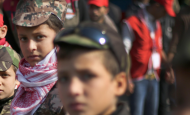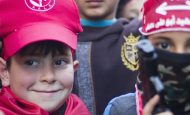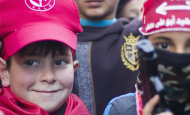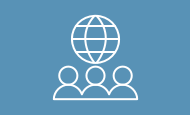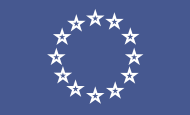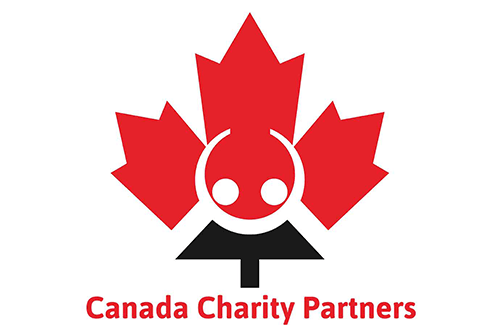Profile
| Country/Territory | United Kingdom |
|---|
| Website | www.savethechildren.org |
|---|
| In their own words | The “leading independent organization creating lasting change in the lives of children in need...” |
|---|
Funding
- In 2022, total income was $1.1 billion; total expenses were $1.1 billion.
- Save the Children has received grants from Norway, Italy, Denmark, and Germany for projects in the West Bank and Gaza. (See table below for further funding information.)
- “Foundation Partners” include Goldman Sachs, Fidelity, the Bill and Melinda Gates Foundation, and Open Society Foundation.
- In 2021-2024, Save the Children is an implementing partner on a €3,295,308 project funded by the European Union titled “Adolescents and Youth (AYS) For Green: Gaza Resilient Economy and Environment.”
- In 2021-2022, Italy granted $17,000 to Save the Children, in partnership with Islamic Relief Palestine (IRPAL) and Vento di Terra.
- On June 19, 2014, Israel’s Defense Minister declared Islamic Relief Worldwide to be illegal, based on its alleged role in funneling money to Hamas, and banned it from operating in Israel and the West Bank. (Hamas is a designated terror organization by Israel, the U.S., EU, and Canada.) According to news reports, the decision was made after “the Israel Security Agency (Shin Bet), the coordinator for government activities in the territories, and legal authorities provided incriminating information against IRW.”
- In 2019-2023, Save the Children received $2,521,583 for a project to “Focus on the monitoring of child rights including improving state capacity to monitor and report to the UN Committe [sic] on the Rights of the Child; strengthening of national systems and building awareness and capacity of civil society to promote and defend child rights.”
- In 2021-2022, Germany ($1,100,110) and Norway ($228,801) funded a project with Save the Children for the “strengthening of the MRM/CAAAC [sic] documentation” in schools in Israel, the West Bank, and Gaza. (See more on Save the Children’s CAAC campaign below.)
- In 2021, Save the Children received $419 million in “grants and contracts” from the United States.
- In 2022, Save the Children received $1.2 million from the UN OCHA occupied Palestinian territory Humanitarian Fund for “Emergency quality education support to conflict affected schools and students,” “Ensuring Access to Quality and Inclusive Education for Vulnerable Children,” and “Urgent Food E-Voucher support for the most vulnerable families in Gaza strip.”
Activities
- Save the Children claims that while they work with “other organizations, governments, non-profits and a variety of local partners,” they maintain “independence without political agenda or religious orientation.”
- Save the Children runs a number of projects in Gaza and the West Bank, implementing “programs in the areas of education, economic opportunities and psychosocial health… humanitarian assistance, child protection and youth development.”
- Despite a humanitarian mandate, some of these programs include major political and partisan advocacy that fuels the conflict, echoing the Palestinian narrative of victimization.
- In May 2023, Save the Children and the Palestinian Center for Human Rights (PCHR) held two training courses on “the mechanisms of monitoring and documenting child rights violations,” and to “child rights advocacy locally and internationally in light of the recurrence of violations against children in Palestine due to the Israeli systematic practices.” The training sessions were funded by Sweden.
- As a member of the Association of International Development Agencies (AIDA), Save the Children has been a signatory on numerous statements demonizing Israel.
- In November 2021, AIDA published a press release condemning the decision by the Israeli Ministry to designate six Palestinian NGOs as terrorist organizations. According to AIDA, “The decision is a further erosion of civic and humanitarian space and stands to significantly constrain the work of the six organisations which have worked with the international community, including the UN, for decades, providing essential services to countless Palestinians.”
- In May 2020, AIDA called for “third states, the EU, and its member states, to devise and publish an exhaustive list of countermeasures to adopt in order to disincentivise Israel’s annexation policies in the occupied Palestinian territory.”
- In October 2020, Save the Children published a report on “the impact of the Israeli military detention system on Palestinian children.” Save the Children itself acknowledged that the data presented in the publication “is not a statistically significant or representative sample. As the report intentionally presents children’s experience from their own perspective, it is also important to note that incidents they mention have not been independently verified by Save the Children” (emphases added). The report severely downplays the extent and severity of violence committed by Palestinian minors against Israeli civilians and soldiers, and ignores the widespread phenomena of incitement prevalent in the West Bank.
- In November 2018, during the violence on the Gaza border, Save the Children stated that “The Israeli government must end the use of sniper fire and live ammunition against children in Gaza. The killing and wounding of children is never acceptable.” Save the Children does not question why these children were present in an obviously violent situation where there was a known potential for injury, nor does the organization condemn Hamas and other Palestinian terror groups’ recruitment and use of children throughout the violence. The NGO also ignored the violent nature of the protests, which have consisted of an organized armed attack on the Israeli border and IDF positions, attempts to destroy and breach the border fence, and sustained arson, rocket, and mortar attacks on Israeli civilian communities.
- On May 18, 2018, Save the Children and the Palestinian Center for Democracy and Conflict Resolution sponsored a workshop at the Dar al Huda kindergarten, “Training of Teachers on Positive Discipline in Everyday Teaching.”
- On May 26, 2018, the Dar al Huda kindergarten in Gaza held a graduation ceremony that included the mock killing and kidnapping of Israelis by children dressed as combatants.1 The simulation included sophisticated equipment such as drones, body cameras, military fatigues, body armor, and sniper camouflage. Children wore headbands representing Palestinian Islamic Jihad (PIJ), designated as a terrorist organization by the US, EU, and others.
- According to the Meir Amit Intelligence and Terrorism Information Center, Dar al Huda held similarly exploitative military-style events in in 2017 and 2016.
- In February 2018, as a member of Association of International Development Agencies (AIDA), Save the Children published a report titled “50 Years of Occupation: Dispossession, Deprivation and De-development” that accused Israel of “systemic, decades-long squeeze of Palestinian economic prospects and human rights.”
- In September 2017, Save the Children published an article titled “Gaza: One Million Palestinian Children in ‘Unlivable’ Conditions” blaming Israel for a “decade of isolation” of Gaza that “had reduced power available to households…” It also called on Israel to blindly “lift the Gaza blockade,” without acknowledging the rationale behind it – to prevent weapon smuggling into Hamas-controlled Gaza. The publication also does not mention the word “Hamas” or the commandeering of aid by the terror group, and minimizes the role of Egypt.
- In August 2017, to mark World Humanitarian Day, Save the Children referred to an “alarming rise in abuses” and claimed that “After 50 years of occupation, generations of Palestinian children remain trapped in an ongoing cycle of violence and diminishing human rights” and “are being denied a future.”
- In August 2017, Save the Children accused Israel of “target[ing]” Palestinian “educational facilities” and alleged that children “face countless threats in simply trying to reach school and enjoy their basic right to education. These threats include: violence and harassment from settlers/Israeli soldiers on the journey to school, military activity in or around their schools, military or police arresting and detaining children from their classrooms, lost time due to the closure of a military area or firing zone, delays crossing checkpoints…” Save the Children ignored Palestinian incitement of children for violence, the use of schools to indoctrinate children with antisemitic and violent propaganda, and the recruitment and use of Palestinian children by armed groups.
- During the 2014 Gaza conflict, Save the Children published a full-page advertisement in papers throughout the UK of the names of Palestinian children who were killed; a similar list of Israeli children was not produced. Similarly, Save the Children Australia released a highly emotive YouTube video, “One child killed every hour in the Israel/ Gaza conflict” (August 5, 2014), concluding with a call to “Stop the use of explosive weapons in Gaza and Israel. End the blockade.”
- Similarly, in a 2013 report “Attacks on Education,” disproportionate emphasis is placed on the alleged challenges to child education in Gaza, with little mention of the obstacles Israeli children face as a result of illegal rocket attacks.
- The organization’s statement on the Gaza conflict in November 2012 focused on children in Gaza entirely and omitted the devastating impact of missile attacks targeting civilians in Israel, including children in Sderot and other southern cities.
Campaign to Blacklist the IDF
- Save the Children is a member of UNICEF’s “Working Group on Grave Violations against Children” aimed at undertaking “consolidated efforts to monitor and report on grave violations against children in Israel and the occupied Palestinian territory (oPt).” (Read NGO Monitor’s Report “UNICEF and its NGO Working Group: Failing Children.)
- In May 2022, as part of a campaign to have Israel included on a UN blacklist of “grave” violators of children’s rights, Save the Children was a signatory on a letter to the UN Secretary-General “reiterat[ing] our call to ensure that all parties to conflict responsible for committing a pattern of grave violations against children are listed in the annexes…Of similar concern, Israeli government forces have never been listed in the annexes.”
- In a May 2015 webinar, Save the Children’s Monitoring and Evaluation Manager Hazem Salama stated, “We are trying to get the IDF listed…we started a national and international advocacy initiative as a part of the Working Group… We were really pushing through the UN agencies and other channels.”
- In April 2020, Save the Children published a report titled “Danger is Our Reality: The impact of conflict and the occupation on education in the West Bank of the occupied Palestinian territory.” In the report, Save the Children created false standards and definitions, however it admitted that even their own contrived standards is not sufficient to claim Israeli violations, and noted that “many of the incidents that children reported to us fall outside, for example incidents relating to heavily armed military or settlers that make them feel unsafe in the classroom, or on their way to and from school. However, we give them equal weight and representation in this report” (emphasis added).
Partners
- Partners with Ma’an Development Center.
- Save the Children is a member of the UN Education Cluster, Health and Nutrition Cluster, and WASH Cluster.
- Member of the “Displacement Work Group,” an initiative of Badil and OCHA, comprising NGOs including: Addameer, Al-Haq, Al-Mezan, AIC, ARIJ, Badil, BIMKOM, B’Tselem, CARE Intnl., DCI – Palestine section, Diakonia, EAPPI, Ir Amim, ICAHD, Maan Development Ctr, MAP UK, Oxfam UK, Oxfam Solidarite – Belgium, PA Govt. Spokesperson, PCHR, RHR, Society of St. Yves, Shatil, UNFPA, ACRI, UNFPA, WCLAC, World Vision, and Yesh Din.
- Save the Children is a member of UNICEF’s “Working Group on Grave Violations against Children” aimed at undertaking “consolidated efforts to monitor and report on grave violations against children in Israel and the occupied Palestinian territory (oPt).” (Read NGO Monitor’s Report “UNICEF and its NGO Working Group: Failing Children.)
- Member of Association of International Development Agencies (AIDA).
Grants to Save the Children for Israel, the West Bank, and Gaza (amounts in $US)
| Donor | 2023 | 2022 | 2021 | 2020 | 2019 |
| Germany | | 1,100,110 | 1,100,110 | 1,100,110 | |
| Denmark | | 12,738 | 293,064 | 147,124 | |
| Norway | 1,835,481 | 228,801 | 982,247 | 591,758 | 117,000 |
| Canada | | | | | 756,079 |
| European Union | | 211,268 | 633,803 | 1,056,338 | |
| United States | 3,651,492 | | | | |
Related Articles
Reports
On October 27, the Canadian government announced it would match donations, up to $10 million, for the Humanitarian Coalition’s Gaza Humanitarian Emergency Appeal.
Reports
Palestinian and international NGOs – funded by European governments and working in tandem with UNICEF’s West Bank and Gaza branch – have built an extensive campaign, using false charges of abuse of Palestinian children in the effort to trigger sanctions against Israel.
Reports
Save the Children has produced an inaccurate report that presents a very politicized narrative that is clearly designed to demonize Israelis, not to protect minors.
Reports
UNICEF spearheads a campaign to have Israel included on a UN blacklist of “grave” vio-lators of children’s rights. This political agenda is a primary facet of UNICEF’s activities relating to Israel, completely inconsistent with its mandate of “child protection” and from its guidelines for neutrality and impartiality.
Blog
Between July 2015 and August 2017, Save the Children did not issue any statements relating to Israel, and it had not initiated a campaign focusing on Israel since May 2016. Since mid-August, however, Save the Children has resumed its campaign against Israel.
Reports
Since 2010, six documents from the offices of EU representatives in Israel and the PA have been leaked to the media. The documents repeat many of the false, inaccurate or misleading allegations made by a select group of NGOs that receive much of their funding from the EU and member states.
Reports
Prior to the ruling of the ICJ on Israels security barrier, SCF released its own one-sided political analysis, violating its mandate, presenting a distorted version of the Israeli-Palestinian conflict through a pro-Palestinian filter, while ignoring the rights of Israeli children.
Reports
The Eye to Eye project, an educational project launched to draw attention to the humanitarian issues of the millions of Palestinian refugees languishing in poverty in the West Bank, Gaza and many Arab states presents a highly misleading picture.
Reports
None of these groups condemned the rocket attacks from Gaza - each one a war crime - targeting Israeli civilians, which had intensified in the week before and triggered the Israeli response. Updated November 22, 2012
All Articles about Save the Children

